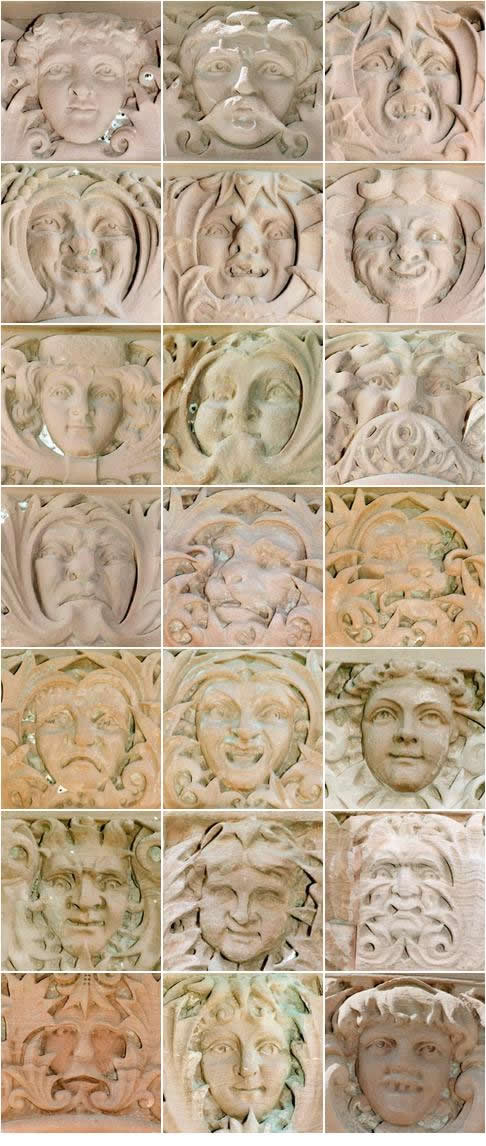|
|

"Three
artisians were brought from Italy to hand carve the stonework. One
of the sculptors became so infatuated with his landlady's daughter
that he carved her face into one of the blocks in the arch of the
east entrance of the courthouse. The story says that the young woman
spurned the sculptor's attention and he became so angry that he carved
other faces that grew progressively more ugly.
There are other likenesses carved into the building's stone decorations
- some so ugly that residents claim they are townspeople of the 1890s
that the young Italian artisans came to dislike." - From Texas Auto
Trails: The Northeast by Myra Hargrave McIlvain UT Press, 1984
"The contractor brought in three stone carvers from Italy to carve
the decorations. The decorations include one very appealing female
face and an assortment of male and female faces in varying degrees
of ugliness. The story is that one of the stone carvers fell for his
landlady's daughter. He supposedly carved the pretty face as a likeness
of her when he thought she might find something interesting in him.
She never did, and the story is he carved the ugly faces to express
his general dissatisfaction with the town and its people after the
landlady's daughter married someone else." - Ray Miller's Eyes of
Texas Travel Guide - 1978
Composition photo © Sam
Fenstermacher |
Editor's
Note:
While J. Reily Gordon often incorporated small ornamental faces on
some of his buildings, none was as populated (or infested) with faces
as the Ellis County
Courthouse in Waxahachie.
As the faces started appearing they caught the attention of the sidewalk
superintendents and before long the entire town was speculating on
their meaning - or trying to identify individuals.
Since no one was willing to come forward and explain the carvings,
speculation turned to legend. A few names are repeated in most accounts
- nationalities of the stone carvers vary. All agree she was the landlady's
daughter.
Sources identified beneath each version |
"The
building's beauty and symmetry is stunning from afar, but it is the
intricate sculptures that grace the
courthouse's exterior that have attracted the most attention and
speculation.
A series of intricately carves stone faces grace each of the four
porch capitals, ranging from the sublime to the grotesque. Legend
has it that German itinerant stone carver Harry Herley fell in love
with the local girl Mabel Frame, whose grandmother operated the boarding
house where he resided while sculpting all the courthouse's exterior
ornamentation. Herley loved Mabel Frame dearly, the myth proclaims,
but she did not return his love. The beautiful likenesses of Mabel
portrayed on the stone porticoes soon turned into demons. Time and
the dwindling love affair are portrayed as one walks around the courthouse.
While a lovely legend, there is no factual basis for the story. Harry
Herley is credited with being the master carver for the Waxahachie
project, but more than likely, he carved only a portion of the portraits
and supervised several other carvers, all of whom worked for Theodore
Beilharz, a master stone carver in Dallas.
The carvings were probably made in Dallas
at the Beilharz yard and shop and shipped to Waxahachie
in their finished condition, ready to mount.
No connection between Herley and Frame can be documented and soon
after the carvings were finished, Herley married a woman named Minnie
Hodges. Despite the lack of evidence, the legend regarding the
courthouse portraits survives and adds an extra element of romance
and intrigue to an already significant architectural landmark." -
Kelly McMichael Stott - Waxahachie: Where Cotton Reigned King, Arcadia
Publishing, 2002. |
| |
Waxahachie
History
Waxahachie:
Where Cotton Reigned King
by Kelly McMichael Stott
Photographs Courtesy of
The Ellis County Historical Museum
Arcadia Publishing's
The Making of America Series.
December 2002 |
|
|

